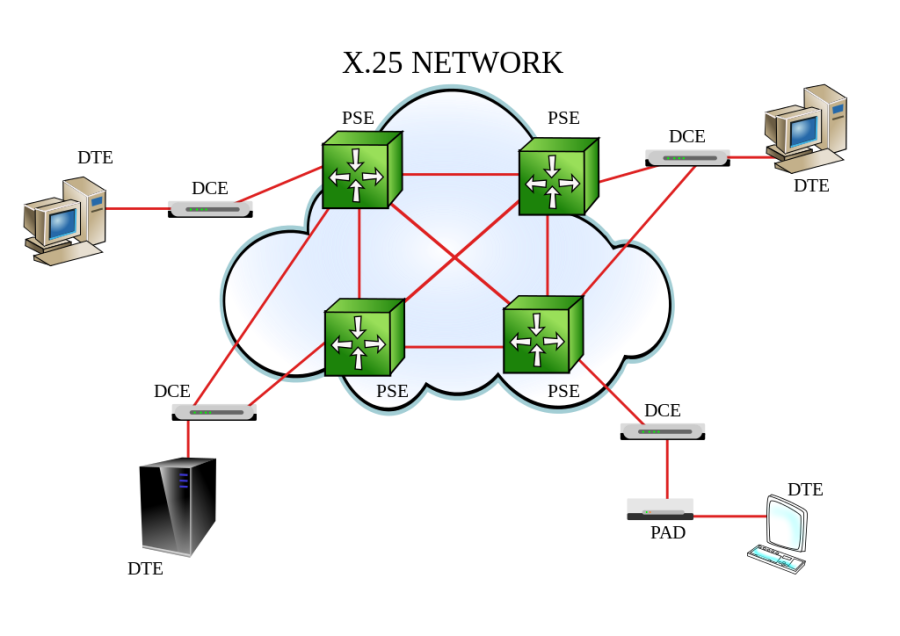X.25 | X.25 is an ITU-T standard protocol suite for packet switched wide area network (WAN) communication. An X.25 WAN consists of packet-switching exchange (PSE) nodes as the networking hardware, and leased lines, plain old telephone service connections, or ISDN connections as physical links. | |
X.509 | In cryptography, X.509 is an International Telecommunication Union (ITU) standard defining the format of public key certificates. X.509 certificates are used in many Internet protocols, including TLS/SSL, which is the basis for HTTPS, the secure protocol for browsing the web. They are also used in offline applications, like electronic signatures. An X.509 certificate binds an identity to a public key using a digital signature. A certificate contains an identity (a hostname, or an organization, or an individual) and a public key (RSA, DSA, ECDSA, ed25519, etc.), and is either signed by a certificate authority or is self-signed. When a certificate is signed by a trusted certificate authority, or validated by other means, someone holding that certificate can use the public key it contains to establish secure communications with another party, or validate documents digitally signed by the corresponding private key. X.509 also defines certificate revocation lists, which are a means to distribute information about certificates that have been deemed invalid by a signing authority, as well as a certification path validation algorithm, which allows for certificates to be signed by intermediate CA certificates, which are, in turn, signed by other certificates, eventually reaching a trust anchor. X.509 is defined by the International Telecommunications Union's "Standardization Sector" (ITU-T), in ITU-T Study Group 17 and is based on ASN.1, another ITU-T standard. | |
XML | Extensible Markup Language | In computing, Extensible Markup Language (XML) is a markup language that defines a set of rules for encoding documents in a format that is both human-readable and machine-readable. The W3C's XML 1.0 Specification and several other related specifications—all of them free open standards—define XML. |
XML Schema | An XML schema is a description of a type of XML document, typically expressed in terms of constraints on the structure and content of documents of that type, above and beyond the basic syntactical constraints imposed by XML itself. These constraints are generally expressed using some combination of grammatical rules governing the order of elements, Boolean predicates that the content must satisfy, data types governing the content of elements and attributes, and more specialized rules such as uniqueness and referential integrity constraints. | |
XML-RPC | XML-RPC is a remote procedure call (RPC) protocol which uses XML to encode its calls and HTTP as a transport mechanism. "XML-RPC" also refers generically to the use of XML for remote procedure call, independently of the specific protocol. This article is about the protocol named "XML-RPC". | |
XMPP | Extensible Messaging and Presence Protocols | Extensible Messaging and Presence Protocol (XMPP) is a communication protocol for message-oriented middleware based on XML (Extensible Markup Language). It enables the near-real-time exchange of structured yet extensible data between any two or more network entities. Originally named Jabber, the protocol was developed by the Jabber open-source community in 1999 for near real-time instant messaging (IM), presence information, and contact list maintenance. Designed to be extensible, the protocol has been used also for publish-subscribe systems, signalling for VoIP, video, file transfer, gaming, the Internet of Things (IoT) applications such as the smart grid, and social networking services. |
XP | eXtreme Programming | Programming Extreme Programming (XP) is an agile software development framework that aims to produce higher quality software, and higher quality of life for the development team. XP is the most specific of the agile frameworks regarding appropriate engineering practices for software development. |
xsd | XSD (XML Schema Definition), a recommendation of the World Wide Web Consortium (W3C), specifies how to formally describe the elements in an Extensible Markup Language (XML) document. It can be used by programmers to verify each piece of item content in a document. They can check if it adheres to the description of the element it is placed in. | |
XSS | Cross Site Scripting | Cross-site scripting (XSS) is a type of computer security vulnerability typically found in web applications. XSS enables attackers to inject client-side scripts into web pages viewed by other users. A cross-site scripting vulnerability may be used by attackers to bypass access controls such as the same-origin policy. Cross-site scripting carried out on websites accounted for roughly 84% of all security vulnerabilities documented by Symantec as of 2007. Bug bounty company HackerOne in 2017 reported that XSS is still a major threat vector. XSS effects vary in range from petty nuisance to significant security risk, depending on the sensitivity of the data handled by the vulnerable site and the nature of any security mitigation implemented by the site's owner. |
